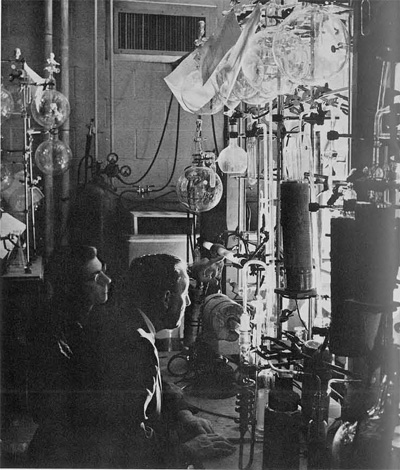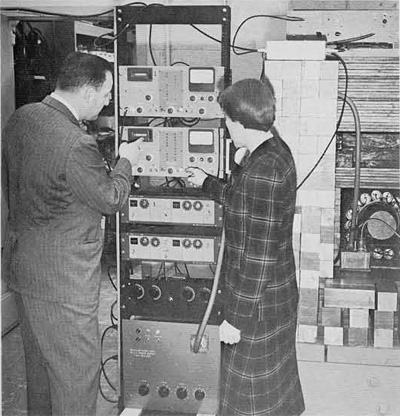
Contamination can be defined variously as pollution, defilement, taint, but to us in the C-14 laboratory it is just double trouble. This unfortunate duality arises from two sources–physical troubles and laboratory troubles. Archaeologists and anthropologists study and excavate in all parts of the world, then bring home or report valuable finds. More can be learned about these prehistoric finds when their ages are known, and it is with their collection that half of the C-14 troubles begin. To fix a chronology by the radiocarbon method, the sample must represent the age of the object to be dated; herein lies the physical problem. If the material is from Arctic regions, it may be a bit of charcoal or pear or antler, but roots from the incongruous lush growth on the surface of the land may have penetrated the subsoil so that our C-14 sample is not just a piece of charcoal but a composite of perhaps Denbigh Flint Culture charcoal infested with modern tree rootlets. We determine its C-14 age, but then what does the date represent–Denbigh Flint or modern rootlets or some indeterminate combination of both?
Fortunately, the physical problem is not always so ambiguous. We are now working with a long series of wooden lintels from the temples of Tikal, Guatemala where the University Museum is engaged in extensive archaeological work. These should be ideal–wooden beams that have been sealed in situ for more than a thousand years. However, in this case, we radioactive chronologers have a special problem. We take our samples from the outer parts of the temple beams because only the outside layers of a tree have contemporary C-14 contents. The inner parts have already ceased to replenish their radiocarbon even though the tree continues to grow. Therefore, if we do not use the outer portion of a temple beam or a minor structural member such as a young limb of a tree, the wood may have been several hundred years old when it was used. If we add this century uncertainty to our C-14 date, then it is of no use in answering the current 260-year disparity in the correlation for the Maya calendar with ours. The solution of this physical problem is simple: take samples from the outer parts of the beams. But, Tikal is in a tropical region and the termites have thrived there. The surfaces of the Tikal temple beams are riddled with holes and the deposits of these insects who probably lived there long after the temples were constructed. Fortunately, this dilemma can be circumvented because the deposits are visible and the wood can be broken up into very fine slivers with each termite’s hole exposed and his remains brushed off.
Bones, as dating materials, are less obvious sources of possible contamination. Bones have very low organic carbon contents and are complex molecules that are subject to chemical exchange. When bones have been heavily charred, however, the organic carbon concentrations are higher and less subject to ground water or atmospheric intrusion. This bone problem is exemplified in our series of dates from the High Andes in Peru and Bolivia. One obvious disparity is from the Tiahuanaco Site, level 9, where a C-14 date for a sample of charcoal was A.D. 256 +/- 103 years and that for slightly charred bones from the same level, A.D. 732 +/-100 years–a discrepancy of five hundred years. Past experience indicates that charcoal is a more reliable material.

The physical problem is only half of the story; laboratory uncertainties provide the other. The standard laboratory errors are three-fold–statistical and the two control point calibrations. The +/- tolerance quoted with each date is comprised of the statistical counting error (which cannot be avoided in counting random radioactive disintegrations) and the uncertainties in the “modern” and “background” control measurements at the time of the “unknown” determination. These last two are our calibration points which are essential for any C-14 date. With our new methods of carbon dioxide proportional counting, we can reduce these to five percent and with great care and stability of equipment, to two percent or less. However, before1956, when we determined these dates by the solid carbon method, our usual error was of the order of plus or minus ten percent plus the additional hazard of “fall-out” contamination from bomb tests. Solid carbon is one of the best absorbers of gases, air, etc. and was therefore subject to artificial radioactivities from “fall-out”. Two things have helped to minimize this hazard–the conversion to carbon dioxide, a gas which can be made and purified without exposure to the atmosphere, and “clean” bombs. A heavy “fall-out” no longer contaminates our natural C-14 counting gas, but could cause “background” fluctuations, that is, give us an erroneously high counting rate. For this reason and also because of the possible occurrence of cosmic ray showers due, for example, to sun spots, we run various monitoring devices in the laboratory. While these are not foolproof, they, at least, indicate when we should suspect the introduction of laboratory fluctuations.
The stability of our counting equipment is another problem and for this reason we make weekly checks of our calibration points, the so-called “modern” and “background” counting rates. When these are stable, when no “fall-out” nor cosmic ray shower has been noted, when the sample is representative of its age and no physical contamination has been introduced, then we have a C-14 date. Take it or leave it.
Photographs by Ruben Goldberg
